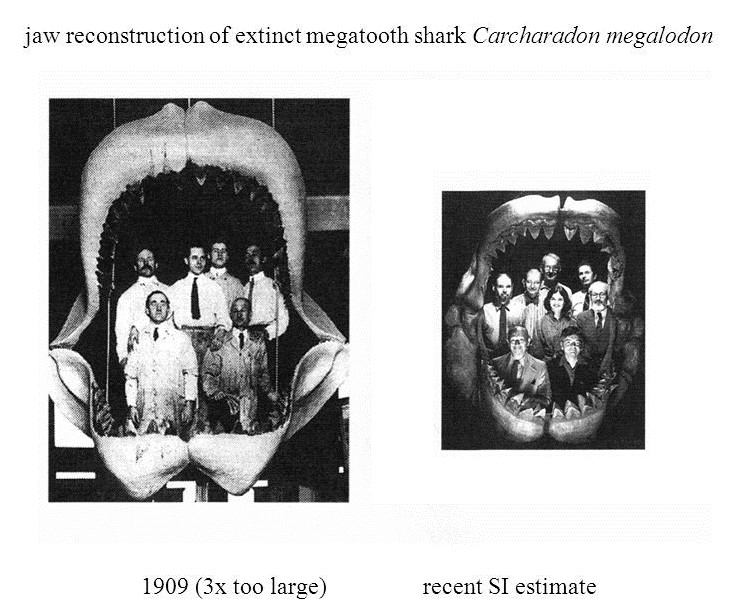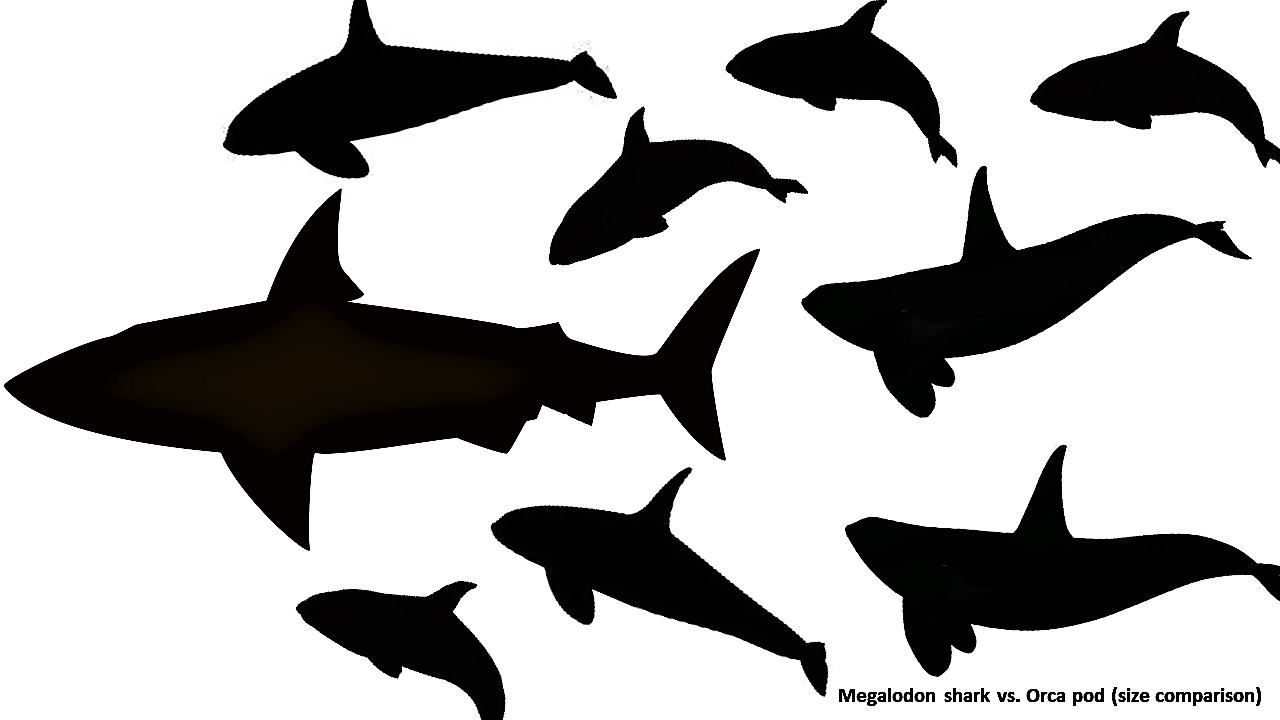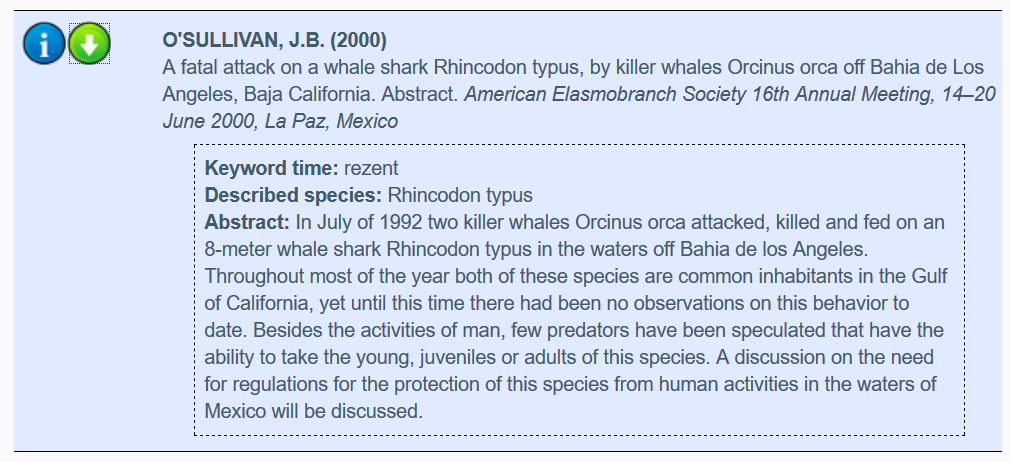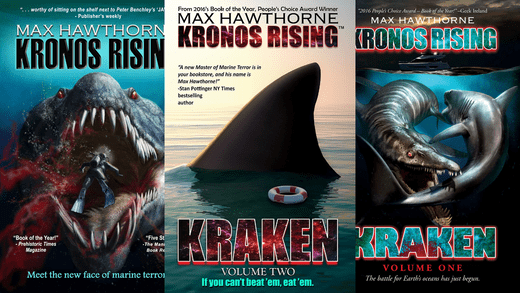The eternal question: What would happen in a real Megalodon Vs Orca fight to the death? Did Orcas (Orcinus orca) and the Megalodon shark (Carcharodon or Carcharocles or Otodus megalodon) ever face-off in real life?
And lastly,
if so, did the Orca in any way contribute to the giant shark’s extinction, especially as the cetaceans really began to take hold and the shark’s numbers declined? Fans of both of these apex predators have asked and debated these questions for decades. Today, we’re going to examine what might happen if a hunting pack of killer whales and history’s largest known carnivorous fish faced off in a bloody battle to the death.
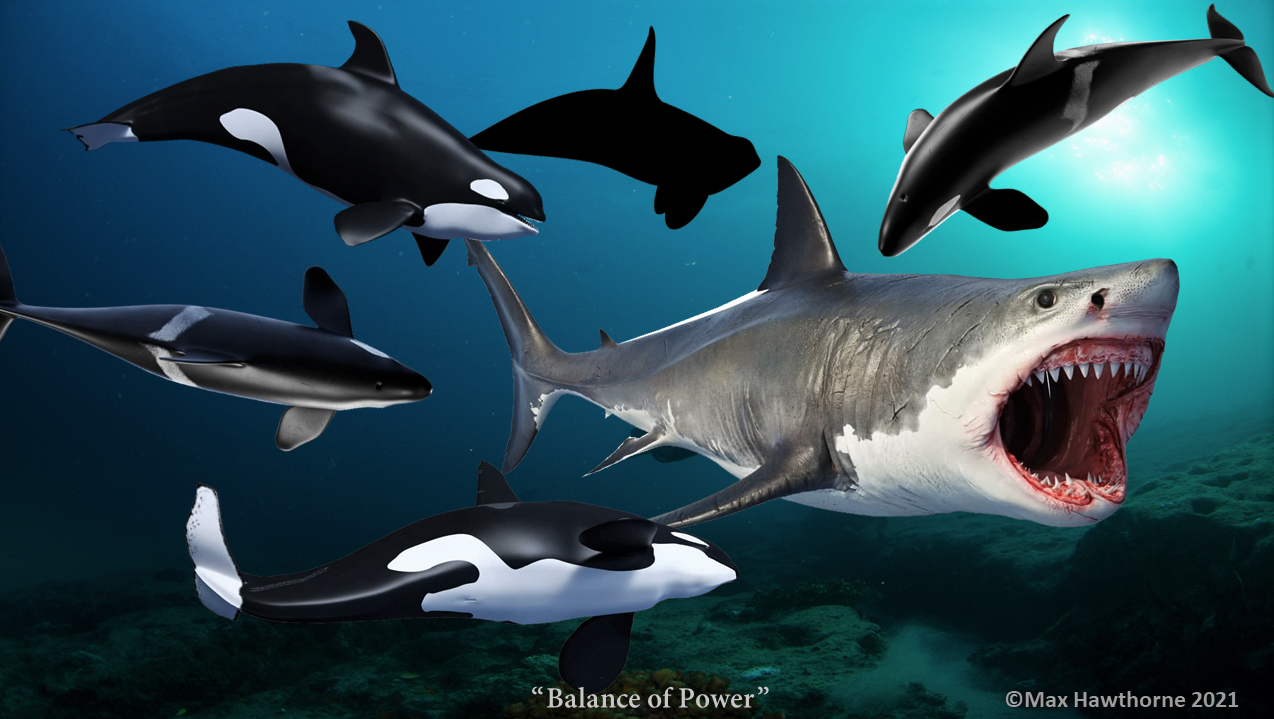
Megalodon Vs Orca
Before we get to the blood and guts, let’s clear up a few points.
1. Size Comparison
First, there’s the issue of size.
It’s a documented fact that Orcas average 16-23 feet for the females (cows) and 20-26 feet for the males (bulls). The largest documented cow Orca was 28 feet long and weighed 8.3 tons, the largest bull 32 feet and 11 tons. Orca statistics.
Megalodon size estimates have been extremely exaggerated over the years, largely due to an endless supply of crappy sci-fi films and size-obsessed fanboy fantasies. In reality, the tooth enamel formula – approx. 10’ for every one inch of enamel height (not overall tooth height) is fairly accurate.
My personal estimate for max size was around 55-56 feet, however, according to the experts, the shark maxed out at approximately 52 feet in length (15.9 meters) and weighed approximately 53 tons (48 tonnes). See the elasmobrancholgist stats here: Megalodon reconstruction
A comparison between the original jaw reconstruction (3X too large) and a more accurate one shows the actual jaw size of the shark – still nothing to sneeze at.
The following illustration shows the comparative size between a full-grown Megalodon shark and a pursuing pod of Orcas. For argument’s sake, the shark is at maximum size, as are two of the Orcas. The remaining animals are average range of individuals. As you can see, the size difference is not as great as one would think.
2. Weaponry
Now, let’s move on to everyone’s favorite topic in Megalodon Vs Orcas: weaponry.
The Megalodon sharks’ jaws were designed to bite with enormous power, and to remove huge chunks of flesh (at larger sizes, to also break apart bones and rib cages to more easily feed on carrion). Maximum overall tooth size (slant height) is around 7.3”.
The teeth, at adult sizes, were thick and heavily reinforced, though not as sharp, pointed, or blade-like as a great white shark of comparable size. They would be the equivalent of chisels with hacksaw blade edges, and capable of inflicting horrific damage. Orca teeth are smaller – usually around 4” in length.
They are conical, pointed, slightly curved, and interlock to help tear flesh. Killer whales’ jaws are not designed to excise flesh, per se, but rather, to rip and immobilize. Their huge jaw bones and muscles are designed to clamp down and neutralize the struggles of much larger prey (fast forward to 1:15 of video to see footage of an Orca seizing the flukes of a much larger fin whale and pulling backwards, prior to the finback being killed).
Orca pod preying on 70′ fin whale
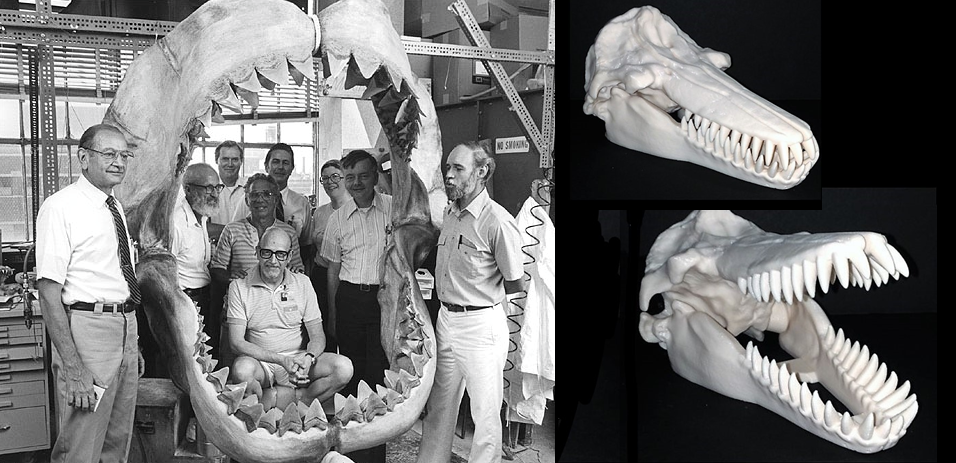
3. Speed and Maneuverability
Now, let’s discuss important factors: speed and maneuverability. In this Megalodon Vs Orca battle. Unfortunately for the shark, it comes up short in this area. The combination of sheer mass and the limitations of a cartilaginous skeleton make an adult Megalodon shark a comparatively slow swimmer.
This video gives an excellent demonstration as to how soft the cartilage-based bones of a large shark are. This is a major Achilles heel when it comes to top-end speed, as the soft bones limit both the speed and strength of the muscular contractions necessary to drive the caudal fin of a large shark.
You can’t build a skyscraper using girders made of tire rubber. The same fact applies to cartilaginous fish.
In terms of calculating Megalodon’s speed, if we compare it to other large sharks (3 mph for both the 60-foot whale and 40-foot basking shark) one might assume it to be a veritable slug. Basking shark swimming speed. However, the extinct shark was most likely at least partly warm-blooded, allowing for faster muscular contractions than these cold-blooded plankton feeders (though still limited by its mass and lack of a bony skeleton).
Keep in mind, plankton feeders are not necessarily slothful.
The blue whale swims at 30 mph. That said, comparing Megalodon instead to the extant great white, and then taking into account that even the white shark slows down considerably at larger, bulkier sizes (7-meter great white, largest ever filmed) from its maximum speed of 30 mph, I estimate a full-grown Megalodon would have a cruising speed similar to that of a sperm whale (3-9 mph) and, being a predator, a maximum speed when charging of 12-14 mph. Stamina is, with any bulky shark, questionable.
The Orca, on the other hand, with its bony skeleton and powerful musculature, is a literal speed demon, cruising at 30 mph and capable of bursts of even 40 (35 knots).
Moreover, it can maintain this speed for prolonged periods of time. Maneuverability in combat is also the killer whale’s forte, a well known and established fact.
4. Intelligence
When it comes to intelligence, the Orca again gets the nod. A proven pack hunter, able to outwit and outmaneuver much larger prey items, and known for its complex social skills and learning behavior, the killer whale ranks as one of the most intelligent non-primates on the planet.
Sharks basically function via instinct, whereas the world’s largest dolphins are capable of calculating another animal’s weaknesses and then exploiting it (their assorted techniques of preying on great whites is a perfect example)
Skin/Protection. Sharks have thick, tough skin, whales have skin and blubber. Obviously, an Orca falling into the jaws of a Megalodon shark would suffer horrible – probably fatal – wounds.
But how tough is the shark’s skin? Some would think that the killer whale, with its 4-inch teeth, would be unable to inflict a mortal wound on its larger opponent. Let’s consider whale sharks, which possess the thickest skin of any shark – up to 8 inches. They need it, as it’s their only defense against predators. However, a pair of Orcas easily killed a 26-foot whale shark and feasted on its liver. Orca facts
Note: the above excerpt (originally in Wikipedia) was edited out last year for some reason, replaced with “Orca’s are known to prey on small whale sharks,” or some such. 8 meters (26 feet) is not small, it’s the size of a bull Orca, and its skin would be as thick as any Megalodon’s.
5. Intimidation Factor
In the fight Megalodon Vs Orca when it comes to the intimidation factor, the Megalodon would get the edge in a straight-on charge, due to sheer mass and a monstrous set of jaws.
However, in real life,
and especially predator-vs-predator interactions, things don’t always work out that way. Especially when faced with an organized pack with superior speed, numbers, and proven tactics. Grizzly bears are often harassed by wolves a fraction of their size, to the point they jam their rump into the ground in an attempt to protect their vulnerable hindquarters.
The same thing happens with lions when they are swarmed by hyenas a third their mass.
But in the water, when you’re a fish that needs to keep swimming, there is no bottom to use. Battles are more like the aerial combat birds exhibit, and groups of craft crows are quite adept at abusing raptors many times their size.
Even when it comes to mammal vs shark confrontations, sea lions, a usual prey item, have been seen taunting, mobbing, and harassing, great white sharks, including biting their tails and fins. They do this by using their superior speed and maneuverability. The pinniped doesn’t rush at the shark’s jaws – a suicide tactic. Rather, it nips at after vulnerable spots that can’t be protected.
Sea lion harasses and bites prowling white shark
Infuriated Fur seals drive off a great white shark after one of their pups is killed.
Can real Orcas kill much larger predators? Some say no, that they can’t even kill large baleen whales or sperm whales. But that is erroneous. Large baleen whales are often preyed upon by killer whales. In fact, that’s where they got their name. Even blue whales are attacked by Orcas, and although their sheer size sometimes enables them to escape, they also have been killed.
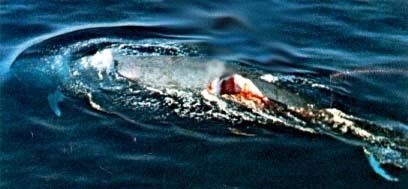
In fact, 25% of adult blue whales bear scars from Orca attacks. Blue whale statistics
To get an idea of the speed and agility advantage Orcas have over a much larger blue whale, observe this drone footage. Nat Geo Drone Footage Orcas VS Blue Whale
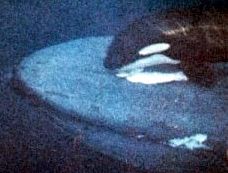

In addition, Orcas do attack and kill adult sperm whale cows, which have teeth, far superior numbers and organization, and reach 36 feet in length and 27 tons. Orcas versus sperm whale pod
It should also be noted that there have been incidents where bull sperm whales organized to help fend off attacks by killer whale pods. The sheer numbers involved bear testimony to the fear the Orca engenders, with ten or even thirty bull sperms joining forces against a pod of eight transient orcas.
Sperm whales versus killer whales – Indian Ocean
Megalodon Vs Orca: Weaknesses
a. Orcas(Killer Whale)
When battling an opponent with gills, the Orcas oft-stated disadvantage is the fact that they’re air-breathers, and need to surface. This is true. Killer whales can only hold their breath for 15 minutes, and usually, surface every 3-4 minutes.
However, one can do a lot of damage in 3 minutes (just ask Mike Tyson), especially, when it’s a group attack, where individuals strike and veer off, or seize and pull, or bite to distract, while another attack is incoming. Additionally, if the Megalodon were to flee into the abyss to escape like other great whites do when they sense one of their number has been killed by Orcas, then the battle is already lost.
However, if the shark stayed to fight – or more likely, could not escape – the cetaceans’ need to breathe becomes a non-issue. Orcas are intelligent enough to herd a large shark toward the surface, to its disadvantage. How? Vicious, damaging bites to vulnerable parts, like the belly and anal fins, would certainly cause any animal to flee, and repeated attacks to this region, as well as to its vulnerable tail and even gills – most of which could not be avoided – would make it easy to prod the fish into going wherever the whales wanted; it would follow their path of least persistence, so to speak.
b. Megalodon
Besides being comparatively slow and unmaneuverable, the Megalodon has two glaring weaknesses.
The first is the sharks’ innate Achilles heel: tonic immobility. The second is its need to keep moving in order to breathe. If the shark is turned over, a state of torpor overcomes it and the battle is over. An even easier way for the huge fish to be worn down by crafty killers is to prevent it from swimming.
With their proven ability to immobilize a finback or even blue whale by pinning its flukes, it would be a simple matter for a large bull Orca to seize a Megalodon’s tail and hold it in place. Soon, the shark would start to weaken and suffocate. And as that was going on, the remainder of the killer whale pod would help it along by tearing, slashing, and bludgeoning it to death. It wouldn’t be pretty.
Last, but not least,
there’s the matter of the cetaceans’ powerful sonar. Besides the fact that it allows them to hunt in complete darkness, Orca sonar is like an X-ray.
It would allow them to see not only the internal anatomy of the shark they were fighting (the locations of its internal organs, where damage was done, how fast its heart was beating, etc), they could even sense its muscles begin to flex before started to move.
Think of a world champion boxer, pitted against a much slower and lumbering opponent. Now, add to the contest, the fact that the pugilist is able to sense each punch coming at him just as it starts. Would he get hit? Not very likely.
We don’t know if Orca sonar, like that of the sperm whale, has any kind of concussive power, like its larger relative uses against giant squid, but at the very least, it would be very stressful and distracting to a large shark – like someone playing loud heavy metal music in your ears while a bunch of people punched and kicked you from every possible direction. It would make it kind of hard to concentrate, don’t you think?
Megalodon Vs Orca: THE ACTUAL FIGHT
To set the stage for Megalodon Vs Orca let us picture a 52-foot Megalodon shark, near the surface, and scavenging on a blue whale carcass. Unfortunately for the shark, that carcass belongs to a local group of killer whales, who don’t appreciate the larger carnivore breaking into their larder.
The approaching Orcas size up their prey, then move in to initiate their assault. The speedier cows lead off, with one sinking its teeth into the huge shark’s vulnerable cloaca and delivering a painful bite. Furious, and having to protect its genitals, the Megalodon turns to fight.
Baring its huge teeth, it rushes the nearest Orca, which dances away. The cetaceans attack again, in and out, biting its vulnerable spot, repeatedly. Soon, the shark’s cloaca is torn and bleeding, and two of its fins are chewed. Alarmed, the shark tries to flee, but like a comparably-sized whale shark, its comparatively slow speed gives it no chance of escaping the faster and sleeker Orcas.
A chase begins, with the Orcas working en masse, slashing at their oversized and now frightened opponent. They begin to focus their attacks on its hindquarters – the pelvic and anal fins, it’s second dorsal, and the sail-like caudal fin that propels it.
The whales keep up their unrelenting assault. When one grows even a little tired, another takes its place. All the while, the stressed-out shark, barraged by the whales’ noisy sonar clicks and excited squeals and disoriented by the confusing and undulating black and white bodies that swirl around it like a herd of zebra, begins to weary. The stress of the assault and the pain of repeated nips and slashes continue to drive it on, however, and it keeps on swimming. It has no built-in instincts on how to fight back against the unrelenting assault and its only attempt at escape – diving deep – is rendered futile, as agonizing bites to its vulnerable gills, belly, and cloaca, drive it back toward the surface where the whales reign supreme.
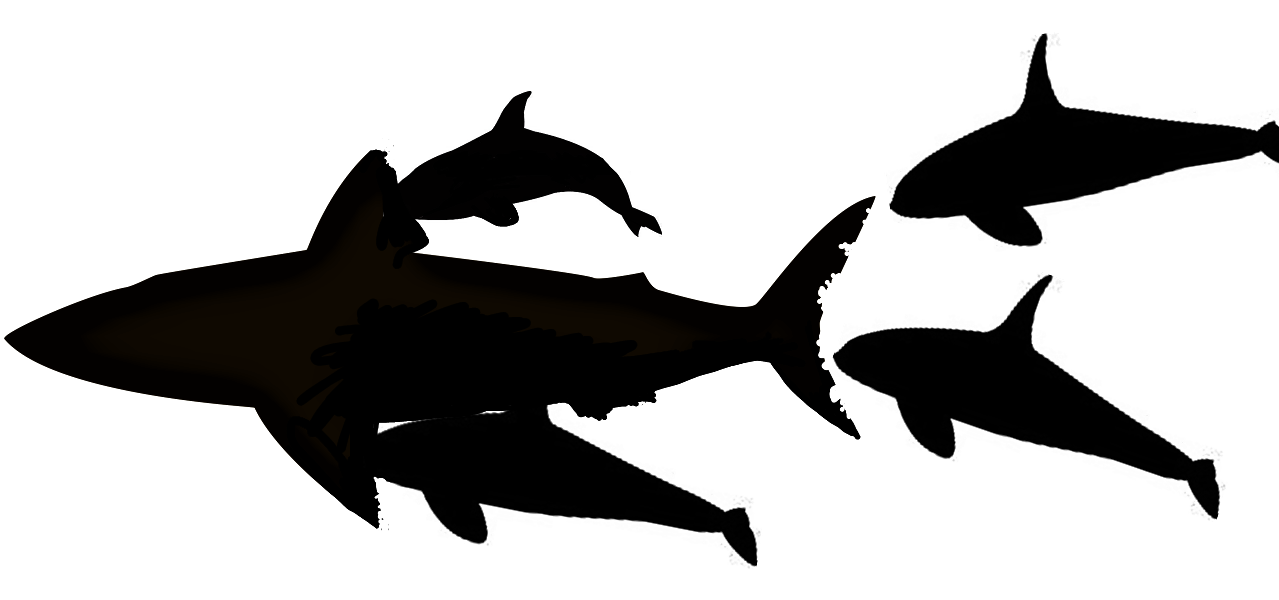
Soon, the shark is exhausted. Bleeding from both of its lacerated gills and with its tail and pectoral fins in tatters, it senses its end is near. Still, its survival instincts force it to continue and, despite the fact that its massive jaws fail to close on any of the crafty and pugnacious Orcas, it refuses to submit.
Suddenly,
the Megalodon begins to panic. Something is wrong with its tail. It’s finding it harder and harder to propel itself along by sweeps of its huge caudal fin. The reason becomes apparent; two huge bull Orcas have latched onto its ten-foot tail, top, and bottom, and are hauling backward with all their might.
The shark is now at a dead stop and, without seawater moving over its gills, its oxygen supply is cut off. It becomes desperate. It flails and thrashes from side to side, tries to twist and turn. Then, an agile cow orca seizes its left pectoral fin and another the right.
The whales are now guiding it where they want to go, like a big puppet, while the other members of the pod ram and bite at its vulnerable belly, rupturing its internal organs. The Megalodon feels the agonizing pain of its gills being shredded and then its body begins to turn. It starts to blackout from loss of oxygen, but not before it realizes it’s upside down.
A strange feeling of paralysis comes over it and it discovers that it cannot move. The Orcas have no such problem, however, as they work together to tear open its belly and begin extracting its nutrient-rich liver.
The last thing the giant shark sees before its abandoned body sinks into the depths is the pod of jubilant killer whales playing a celebratory game; a tug-of-war with its tube-like internal organ gripped tightly in their toothy jaws, pulled back and forth through rapidly-dissipating billows of blood.
That Concludes our Megalodon Vs Killer whale Battle.
Passionate Megalodon fans may rail at this predicted outcome and that’s expected and respected. However, (and as anyone who’s read the Kronos Rising series knows), I do extensive research on the marine animals I write about, and that is 100% how I see a battle between killer whales and a Megalodon panning out.
The odds are overwhelmingly on the side of the cetaceans. Of course, opinions are subjective, but when you look at all the facts and all the combined evidence, it’s the only outcome that makes sense.
And, of course, as we know, Orcas are still here. To the best of our knowledge, Megalodon isn’t.* That just might mean something.
Thanks for taking the time to read this article. If you’re interested in an all-out brawl between a pod of Orcas and a 25-meter macropliosaur, make sure you check out my novel Kronos Rising on Amazon (click the link below for a FREE preview). Kindle is only $7.99 and if you have Prime or Kindle Unlimited, you can read it for free.
Max Hawthorne, author
#princeofpaleofiction
(thanks to Scott Mardis for providing some of the research materials used in this study)
*Stay tuned for an upcoming post where I explore the possibility that Megalodon – or another giant shark – still roams our oceans.
